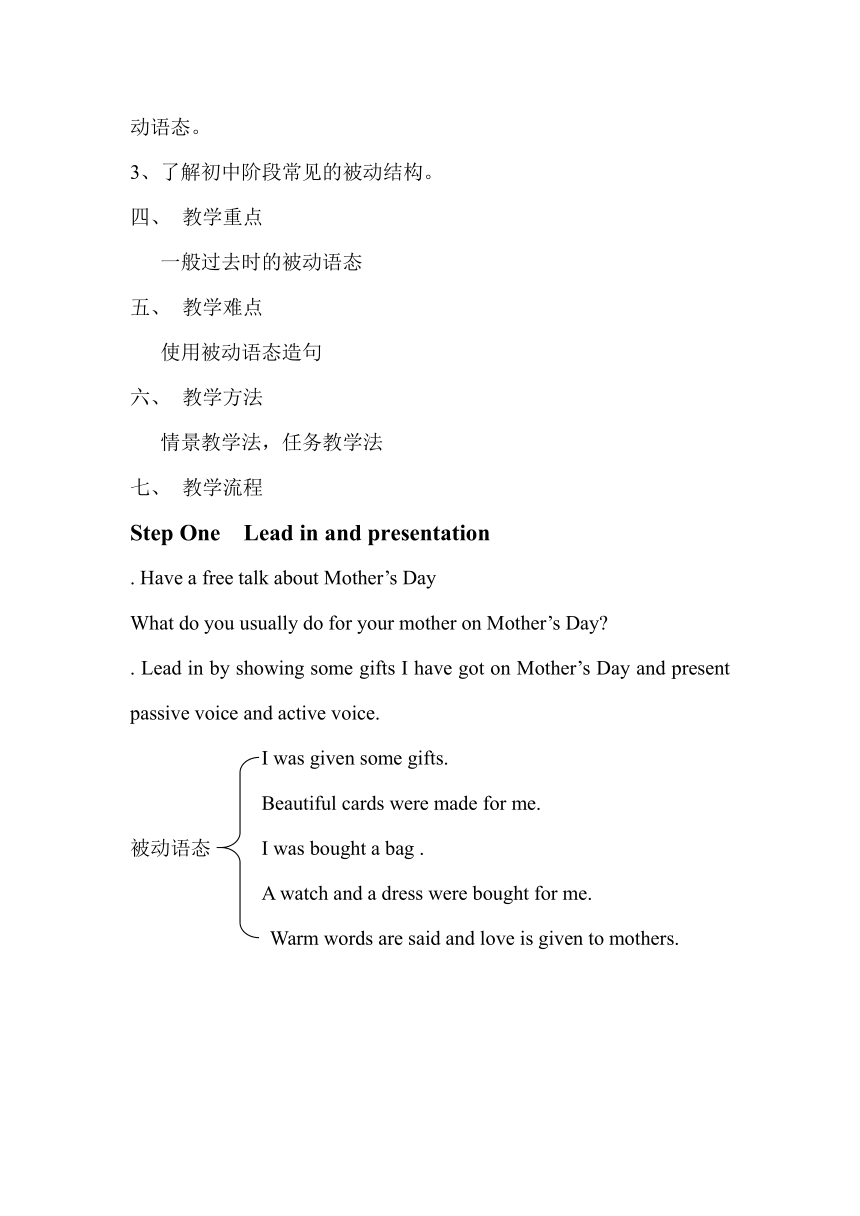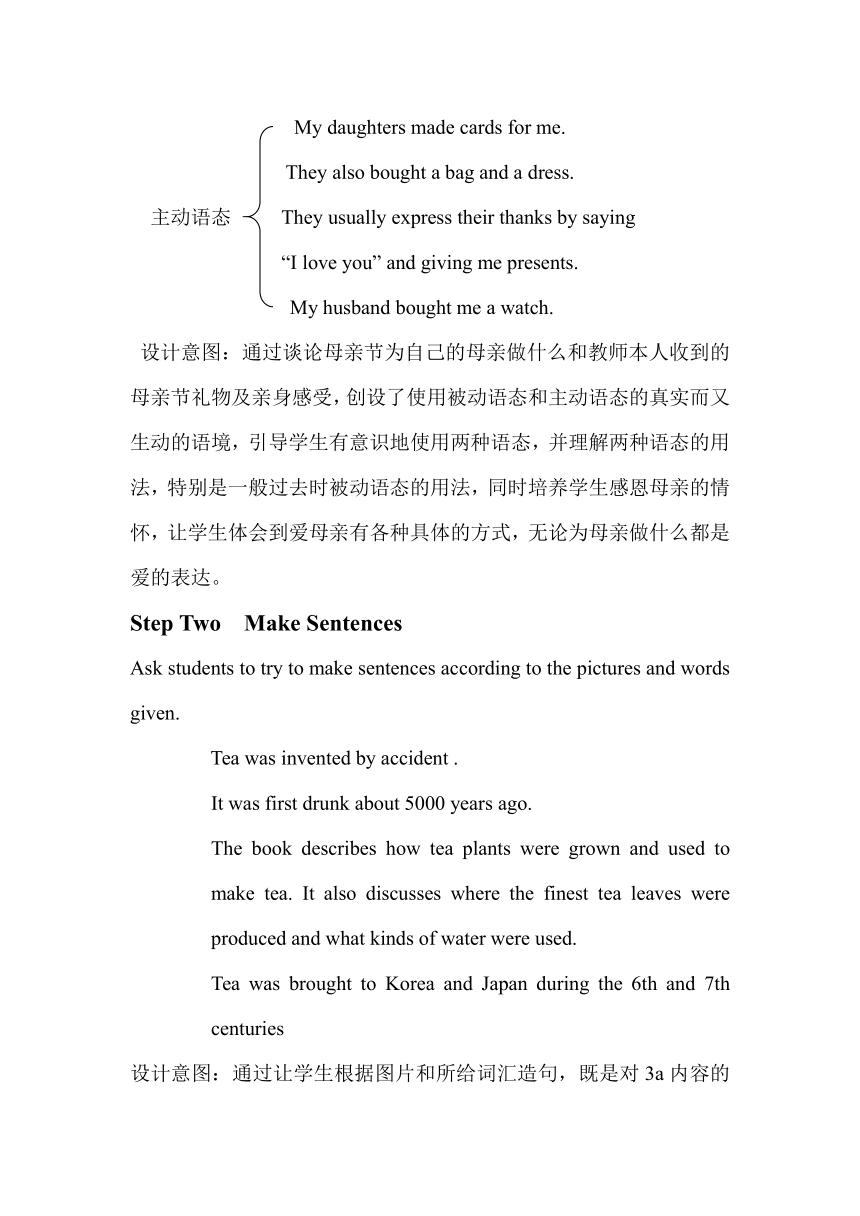人教版九年级全册英语Unit 6 When was it invented?Section A Grammar focus 4a-4c 教案
文档属性
| 名称 | 人教版九年级全册英语Unit 6 When was it invented?Section A Grammar focus 4a-4c 教案 |

|
|
| 格式 | doc | ||
| 文件大小 | 41.0KB | ||
| 资源类型 | 教案 | ||
| 版本资源 | 人教新目标(Go for it)版 | ||
| 科目 | 英语 | ||
| 更新时间 | 2022-11-14 19:04:21 | ||
图片预览



文档简介
Unit 6 When was it invented
Section A (Grammar Focus 4a-4c)
教学设计
1、 教材分析
本课时教材来自人教新目标九年级英语(全一册) Unit 6 Section A (Grammar Focus 4a-4c) ,是一节语法讲练课,所涉及的语法是一般过去时的被动语态。Grammar Focus的句子呈现了本单元的目标语言,提供了使用被动语态的简短情景,并对主动语态和被动语态进行对比,培养学生使用被动语态的意识。4a要求学生把主动语态改成被动语态,在练习当中理解主动语态与被动语态的使用及使用不同语态在语义上的侧重及谓语形式的变化特点。4b、4c 分别以完成单句,语篇的方式进一步练习两种语态的使用。
2、 学情分析
我这节课的授课对象英语程度较好,而且是在中考一轮复习之后对这部分内容进行教学。所以难点不是学生不会用被动语态做选择题甚至是填写动词形式,而是运用被动语态的意识不强,换言之,给出一个汉语意思,如果“被”字没有出现,很多学生想不到使用被动语态。更不能把被动语态用于语言交际当中。
3、 教学目标
1、 通过教学,学生能理解被动语态的使用,并有意识地使用被动语态。
2、学生能准确使用考纲要求的四种时态的被动语态和含有情态的被动语态。
3、了解初中阶段常见的被动结构。
4、 教学重点
一般过去时的被动语态
5、 教学难点
使用被动语态造句
6、 教学方法
情景教学法,任务教学法
7、 教学流程
Step One Lead in and presentation
. Have a free talk about Mother’s Day
What do you usually do for your mother on Mother’s Day
. Lead in by showing some gifts I have got on Mother’s Day and present passive voice and active voice.
I was given some gifts.
Beautiful cards were made for me.
被动语态 I was bought a bag .
A watch and a dress were bought for me.
Warm words are said and love is given to mothers.
My daughters made cards for me.
They also bought a bag and a dress.
主动语态 They usually express their thanks by saying
“I love you” and giving me presents.
My husband bought me a watch.
设计意图:通过谈论母亲节为自己的母亲做什么和教师本人收到的母亲节礼物及亲身感受,创设了使用被动语态和主动语态的真实而又生动的语境,引导学生有意识地使用两种语态,并理解两种语态的用法,特别是一般过去时被动语态的用法,同时培养学生感恩母亲的情怀,让学生体会到爱母亲有各种具体的方式,无论为母亲做什么都是爱的表达。
Step Two Make Sentences
Ask students to try to make sentences according to the pictures and words given.
Tea was invented by accident .
It was first drunk about 5000 years ago.
The book describes how tea plants were grown and used to make tea. It also discusses where the finest tea leaves were produced and what kinds of water were used.
Tea was brought to Korea and Japan during the 6th and 7th centuries
设计意图:通过让学生根据图片和所给词汇造句,既是对3a内容的回顾,又是对这部分内容的再加工。学生在造句同时体会被动语态的使用,即,不知道动作的执行者是谁或没有必要指出动作的执行者,或需要强调动作的承受者。
Step Three Grammar Focus
Ask students to complete the sentences
设计意图:把Grammar Focus 中的句子挖空并让学生完成句子,通过这种方式让学生对被动语态的结构be +动词过去分词有清晰的认知。
Step Four Presentation of Grammar and translation
. Help students to understand how to turn active voice into passive voice by comparing active voice with passive voice
. Present some special forms while learning possive voice.
设计意图:图示形式呈现主动语态和被动语态,帮助学生理解主动语态和被动语态的差异及主动语态变被动语态时各句子成分的变化,尤其是谓语动词形式的变化。通过让学生将汉语翻译成英语,引导学生使用被动语态并关注其陈述,否定及一般疑问形式。通过让学生对一些特殊形式的句子变被动语态和翻译句子,引出主动语态变被动语态的特殊情形和学习使用被动语态时要注意的问题,由一般到特殊,引发学生思考,学生化被动接受为主动学习,调动了学生发现问题及解决问题的积极性。
Step Five Practice
设计意图:
通过形式多样的练习巩固被动语态的结构和用法,引导学生由一般过去时被动语态的结构拓展到中考常见的几种形式的被动语态的结构,帮助学生理解不同时态的被动语态的差异体现在be 动词形式的变化上。
Step Six Exercises and summary
1. Mr. Green_____ to sing an English song at the party and he sang well.
A. was invited B. invited C. is invited D. invites
2. –The empty room is so dirty.
-I know. It ________ for weeks.
A. has cleaned B. hasn’t cleaned
C. has been cleaned D. hasn’t been cleaned.
3.- The children ______to follow the rules from a young age.
- I agree.
A. were educated B. has been educated
C. are educated D. should be educated
4. A new international airport ______ in the city next year.
A. completes B. is completed
C. will complete D. will be completed
5. With the development of China , Chinese _____in more and more schools in foreign countries.
A. teaches B. taught C. is taught D. was taught
设计意图:结合中考考纲进行有针对性的练习,并对初中阶段常见的被动形式进行回顾。
Section A (Grammar Focus 4a-4c)
教学设计
1、 教材分析
本课时教材来自人教新目标九年级英语(全一册) Unit 6 Section A (Grammar Focus 4a-4c) ,是一节语法讲练课,所涉及的语法是一般过去时的被动语态。Grammar Focus的句子呈现了本单元的目标语言,提供了使用被动语态的简短情景,并对主动语态和被动语态进行对比,培养学生使用被动语态的意识。4a要求学生把主动语态改成被动语态,在练习当中理解主动语态与被动语态的使用及使用不同语态在语义上的侧重及谓语形式的变化特点。4b、4c 分别以完成单句,语篇的方式进一步练习两种语态的使用。
2、 学情分析
我这节课的授课对象英语程度较好,而且是在中考一轮复习之后对这部分内容进行教学。所以难点不是学生不会用被动语态做选择题甚至是填写动词形式,而是运用被动语态的意识不强,换言之,给出一个汉语意思,如果“被”字没有出现,很多学生想不到使用被动语态。更不能把被动语态用于语言交际当中。
3、 教学目标
1、 通过教学,学生能理解被动语态的使用,并有意识地使用被动语态。
2、学生能准确使用考纲要求的四种时态的被动语态和含有情态的被动语态。
3、了解初中阶段常见的被动结构。
4、 教学重点
一般过去时的被动语态
5、 教学难点
使用被动语态造句
6、 教学方法
情景教学法,任务教学法
7、 教学流程
Step One Lead in and presentation
. Have a free talk about Mother’s Day
What do you usually do for your mother on Mother’s Day
. Lead in by showing some gifts I have got on Mother’s Day and present passive voice and active voice.
I was given some gifts.
Beautiful cards were made for me.
被动语态 I was bought a bag .
A watch and a dress were bought for me.
Warm words are said and love is given to mothers.
My daughters made cards for me.
They also bought a bag and a dress.
主动语态 They usually express their thanks by saying
“I love you” and giving me presents.
My husband bought me a watch.
设计意图:通过谈论母亲节为自己的母亲做什么和教师本人收到的母亲节礼物及亲身感受,创设了使用被动语态和主动语态的真实而又生动的语境,引导学生有意识地使用两种语态,并理解两种语态的用法,特别是一般过去时被动语态的用法,同时培养学生感恩母亲的情怀,让学生体会到爱母亲有各种具体的方式,无论为母亲做什么都是爱的表达。
Step Two Make Sentences
Ask students to try to make sentences according to the pictures and words given.
Tea was invented by accident .
It was first drunk about 5000 years ago.
The book describes how tea plants were grown and used to make tea. It also discusses where the finest tea leaves were produced and what kinds of water were used.
Tea was brought to Korea and Japan during the 6th and 7th centuries
设计意图:通过让学生根据图片和所给词汇造句,既是对3a内容的回顾,又是对这部分内容的再加工。学生在造句同时体会被动语态的使用,即,不知道动作的执行者是谁或没有必要指出动作的执行者,或需要强调动作的承受者。
Step Three Grammar Focus
Ask students to complete the sentences
设计意图:把Grammar Focus 中的句子挖空并让学生完成句子,通过这种方式让学生对被动语态的结构be +动词过去分词有清晰的认知。
Step Four Presentation of Grammar and translation
. Help students to understand how to turn active voice into passive voice by comparing active voice with passive voice
. Present some special forms while learning possive voice.
设计意图:图示形式呈现主动语态和被动语态,帮助学生理解主动语态和被动语态的差异及主动语态变被动语态时各句子成分的变化,尤其是谓语动词形式的变化。通过让学生将汉语翻译成英语,引导学生使用被动语态并关注其陈述,否定及一般疑问形式。通过让学生对一些特殊形式的句子变被动语态和翻译句子,引出主动语态变被动语态的特殊情形和学习使用被动语态时要注意的问题,由一般到特殊,引发学生思考,学生化被动接受为主动学习,调动了学生发现问题及解决问题的积极性。
Step Five Practice
设计意图:
通过形式多样的练习巩固被动语态的结构和用法,引导学生由一般过去时被动语态的结构拓展到中考常见的几种形式的被动语态的结构,帮助学生理解不同时态的被动语态的差异体现在be 动词形式的变化上。
Step Six Exercises and summary
1. Mr. Green_____ to sing an English song at the party and he sang well.
A. was invited B. invited C. is invited D. invites
2. –The empty room is so dirty.
-I know. It ________ for weeks.
A. has cleaned B. hasn’t cleaned
C. has been cleaned D. hasn’t been cleaned.
3.- The children ______to follow the rules from a young age.
- I agree.
A. were educated B. has been educated
C. are educated D. should be educated
4. A new international airport ______ in the city next year.
A. completes B. is completed
C. will complete D. will be completed
5. With the development of China , Chinese _____in more and more schools in foreign countries.
A. teaches B. taught C. is taught D. was taught
设计意图:结合中考考纲进行有针对性的练习,并对初中阶段常见的被动形式进行回顾。
同课章节目录
- Unit 1 How can we become good learners.
- Section A
- Section B
- Unit 2 I think that mooncakes are delicious!
- Section A
- Section B
- Unit 3 Could you please tell me where the restroom
- Section A
- Section B
- Unit 4 I used to be afraid of the dark.
- Section A
- Section B
- Unit 5 What are the shirts made of?
- Section A
- Section B
- Review of Units 1-5
- Unit 6 When was it invented?
- Section A
- Section B
- Unit 7 Teenagers should be allowed to choose their
- Section A
- Section B
- Unit 8 It must belong to Carla.
- Section A
- Section B
- Unit 9 I like music that I can dance to.
- Section A
- Section B
- Unit 10 You're supposed to shake hands.
- Section A
- Section B
- Review of Units 6-10
- Unit 11 Sad movies make me cry.
- Section A
- Section B
- Unit 12 Life is full of the unexpected
- Section A
- Section B
- Unit 13 We're trying to save the earth!
- Section A
- Section B
- Unit 14 I remember meeting all of you in Grade 7.
- Section A
- Section B
- Review of Units 11-14
